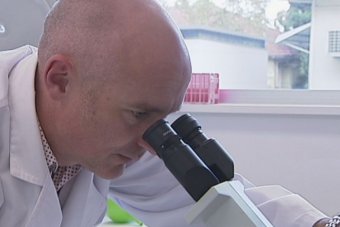Australian researchers are cautiously optimistic after using nanocells to achieve what could be one of the most significant breakthroughs in asbestos-related cancer treatment in a decade.
Scientists from the Chris O’Brien Lifehouse Centre have published a case report of a patient whose mesothelioma has almost entirely disappeared.
Bradley Selmon was one of ten patients in a phase-one clinical trial of a new treatment that used very small genes known as microRNA to inhibit tumour growth.
The genes were transported to the mesothelioma in his right lung using Australian-designed nanocells.
There haven’t been many breakthroughs in the last 10 years so we hope we’ve got something here to give hope to patients.
ADRI Associate Professor Glen Reid
Associate Professor Glen Reid from the Asbestos Diseases Research Institute (ADRI) put the microRNA inside nanocells and said it was like using a Trojan horse.
“A nanocell is a delivery vehicle,” he said.
“You can package basically anything in there that you like, so a chemotherapy drug — or in our case a mini-gene — and then it’s injected into the body.”
Once in the lung, the nanocells delivered the microRNA to the affected lung to inhibit tumour growth.
“He had this quite amazing response where a lot of his cancer cannot be seen on his scan.”
The other nine patients in the trial have either remained stable or continued to decline.
They do not know how long the treatment will work or if it will work in others.
“It’s early days,” Dr Kao said.
About Mesothelioma
- 600 people are diagnosed each year with mesothelioma
- Mostly men get it
- It is often diagnosed late
- The median survival after diagnosis is 12 months
- It can take at least 20 years after exposure to asbestos for mesothelioma to develop
“Hopefully this case will provide some hope to mesothelioma patients that research is being done and we are hopefully advancing therapy options for future patients.”
Mesothelioma is one of the hardest cancers to treat and patients typically do not live long after diagnosis.
There is only one main type of chemotherapy and when it stops working patients have few options.
“There haven’t been many breakthroughs in the last 10 years so we hope we’ve got something here to give hope to patients,” Professor Reid said.
The research is published today in the American journal Respiratory and Critical Care Medicine.
Bradley Selmon feels ‘very lucky’
Bradley Selmon said he remembered inhaling the dust that ultimately led to his diagnosis of mesothelioma.
As a 17-year-old apprentice plumber it was his job to cut fibro sheets to fit plumbing into house walls.
I used to get breathless just walking up a flight of stairs, now I can go bushwalking, I can do whatever I like.
Bradley Selmon
“Every day I was cutting the sheets and there was always asbestos dust everywhere.”
He started to become ill in 2010 but wasn’t diagnosed until 2013.
“I was devastated because I knew there was no cure.”
When chemotherapy stopped working, his oncologist gave him an option: go into a clinical trial or go on a holiday.
He chose the trial and after eight weeks of microRNA treatment his life turned around.
“It’s been fantastic, it’s changed my life,” he said.
“I used to get breathless just walking up a flight of stairs, now I can go bushwalking, I can do whatever I like.
“I feel very lucky because I realise other people may not be so lucky.”
Bernie Banton’s legacy
The ground-breaking research was conducted at the Asbestos Diseases Research Institute at the Bernie Banton Centre.
The facility was set up as a response to the increasing incidence of malignant mesothelioma.
Before his death in 2007, Bernie Banton campaigned vigorously for the rights of those who suffered, like himself, from asbestos-related diseases.
The research facility on the Concord Hospital Campus was named in Mr Banton’s honour in 2009.



